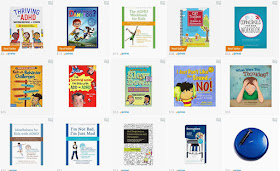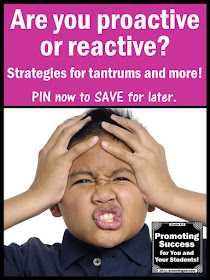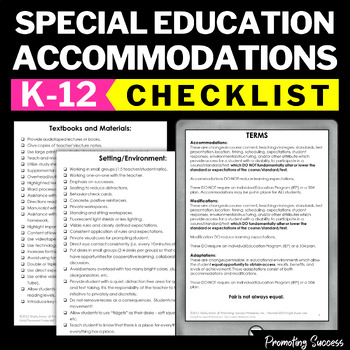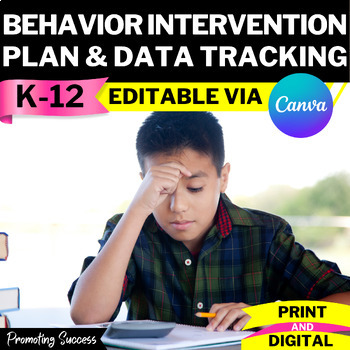Click HERE to view our Teachers Pay Teachers Promoting Success store.
Note: This blog post contains resources from our TpT store and Amazon Associate store.
--------------------------------------------
Last week we discussed managing behavior in terms of reactive or proactive.
Clearly proactive is the preferred choice in terms of modifying the environment and teaching coping skills or replacement behaviors. It is so very important to remember that all behavior is communication. The student isn’t just being “naughty” or “lazy.” There is a purpose for the behavior.
It is our job to determine this purpose – much easier said than done, right?
If the child’s behavior is significantly disrupting the learning of self or others, then I highly recommend conducting a formal behavior analysis and behavior intervention plan. This is NOT necessarily a special education issue and should first be done through general education interventions (Response to Intervention). There are extensive books and research on these topics, so I won’t go into huge detail here.
Next Monday Mall, I will share several recommended books on this topic. Please “JOIN this site,” so you won’t miss any valuable information!
It is always a good idea to collaborate with a behavior resource team, problem solving team, etc. in your school. The key is to target the specific behavior (through data collection), create an intervention plan, and MONITOR progress.
Conducting several interventions at once is a common mistake and nearly impossible to determine what truly is effective or not. In addition, the student may become so overwhelmed that the undesired behavior increases!
(Remember, though, in any intervention plan undesired behaviors may increase before they decrease.)
So let’s target one behavior that is the most disruptive: the tantrum or out of control behavior.
Obviously, it is impossible to teach coping skills when the student is in this “crisis” mode. Therefore, a proactive approach is essential!
Teaching the child a script and/or how to use a “break” card is a great start.
Both of these approaches should be taught over and over and over in a safe, non-triggering environment.
Role play and make it rewarding.
A sample script could be:
1. Take a deep breath.
2. Count to 10.
3. Say, “I can stop _________.”
4. Say, “I can ___________ instead.”
Obviously, it is impossible to teach coping skills when the student is in this “crisis” mode. Therefore, a proactive approach is essential!
Teaching the child a script and/or how to use a “break” card is a great start.
Both of these approaches should be taught over and over and over in a safe, non-triggering environment.
Role play and make it rewarding.
A sample script could be:
1. Take a deep breath.
2. Count to 10.
3. Say, “I can stop _________.”
4. Say, “I can ___________ instead.”
So let’s say you have a student who tends to throw tantrums when he/she has to transition to a new activity. You know this because of careful formal and informal observations and data collection. So his script may look like this:
1. Take a deep breath.
2. Count to 10.
3. “I can stop kicking and screaming.”
4. “I can hold my teddy bear and walk to the next activity.”
On a side note, here are additional proactive environmental modifications for this behavior:
1. Set a 2 minute timer to prep for the transition.
2. Place specific music or different instruments to signal each new, different activity (i.e. drum to math, bell to reading)
3. Use a picture schedule (even if the student can read)
4. Use a “now/next” schedule
Here is another example. Let’s say you have a student who “shuts down” when given an independent task. Once again, you know this from data collection. You target the behavior by teaching the student to use a “help” card. You have collected additional data to determine the tasks are not too difficult and in the students independent to instructional level. Therefore, you believe the student has anxiety regarding getting a problem wrong and the actually starting process.
1. Take a deep breath.
2. Read the directions on the paper.
3. “I can stop not doing my work.”
4. “I can raise my HELP card” or “I can do the first question then raise my HELP card.”
Remember, these scripts will take a lot of practice and reinforcement. It is not appropriate to try to “teach” these scripts when the student is escalated. New routines or scripts must be practiced consistently and positively for the best results.Also, positive behavior supports are essential!
-----------------------
Building Behavioral Expertise Through Academic and Behavior Change
Dr. Laura Riffle
We were able to have Dr. Laura Riffle present to our district a few years ago. Our teachers felt her content was extremely helpful.
Part One
You may also like these autism and special education resources from our TpT store:
For a checklist of 175+ accommodations, click the picture:
---------------------------------------
You may also like these Laura Riffel resources from our Amazon Associate store:
---------------------------------------
Please click HERE to see more books and resources from my Amazon store. I've searched for the best-selling and/or highest rated teaching resources for you! (I earn a small commission.)


---------------------------------------
Click HERE to view our Teachers Pay Teachers Promoting Success store.
Shelly Anton is a participant in the Amazon Services LLC Associates Program, an affiliate advertising program designed to provide a means for sites to earn advertising fees by advertising and linking to Amazon.com. ** This means there are Amazon affiliate links in these blog posts. This does not mean you pay a dime more when you purchase a product through the link. It just means I am trying to save you valuable teacher time by making it easier for you to find valuable resources for your students, and I earn a few cents for my research and time. Thank you for all you do for kids!












